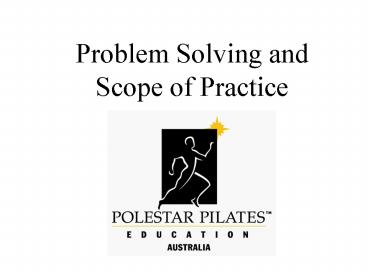Problem Solving and Scope of Practice - PowerPoint PPT Presentation
1 / 19
Title:
Problem Solving and Scope of Practice
Description:
Lesion often the result of instability or poor joint proprioception ... gravity, resistance and in movements requiring proprioception and balance ... – PowerPoint PPT presentation
Number of Views:94
Avg rating:3.0/5.0
Title: Problem Solving and Scope of Practice
1
Problem Solving and Scope of Practice
2
NAGI grid
Problem Goal
Treatment Impairment Functional
Limitation Disability
3
Problem Solving
- Impairment
- Any measurable loss or abnormality of
psychological, physiological, anatomical
structure or function - Examples ROM, strength, tone, swelling,
hypermobility, hypomobility, flexibility or pain
4
Problem Solving
- Functional Limitation
- Any restriction or lack of full function
resulting from an impairment of ability to
perform an activity in the manner or within the
range considered normal for a human being. - Examples Squatting, walking, running, sitting
reaching, writing, bathing, eating, combing hair
5
Problem Solving
- Disability
- A disadvantage for a given individual resulting
from an impairment or disability that limits or
prevents the fulfillment of a role that is normal
for that individual. - Examples work limitations, recreational (or
sports) limitations, community locomotion, social
limitations
6
Stages of Rehabilitation
- Stage 1 Pain Control
- Addresses management of pain through passive
afferent treatment and biomechanical counseling.
Objective is to avoid further irritation of the
lesion, decrease pain and restore pain free ROM. - Biomechanical Counseling is the education of the
patient in daily activities on how to avoid
destructive forces to the lesion.
7
Stage 1 Pain Control
- Stabilization
- Preventing movement at the lesion site.
- Recruitment of controllers or deep stabilizers
(TA and Multifidus) which are type I fibers that
contract isometrically around the lesioned joint
or segment
8
Stage 1 Pain Control
- Disassociation
- Isolation of movement at a desired joint distal
or proximal to the site of the lesion. - Shifts the aggravating force from the site of the
lesion.
9
Stage 2 Begin Non-Destructive Movement
- Restoration of movement with focus on restoring
lost ROM secondary to injury. - Begins after control is established statically
- Lesion often the result of instability or poor
joint proprioception - Instability often accompanied by neighboring
hypomobility - Hypomobility can be due to capsular restrictions
but often due to poor motor planning
10
Stage 2 Begin Non-Destructive Movement
- Incorporate assistance to reduce shear and
facilitate successful movement that supports
joints structures and soft tissues - Use of assistance is crucial and must not be too
aggressive or premature with mobilization - Improve outcome by choosing right degree of
assistance and modification
11
Stage 3 Begin Proprioceptive Training in
Protected Range
- Dynamic Stabilization challenges newly acquired
ROM against gravity, resistance and in movements
requiring proprioception and balance - Challenges control of static trunk
- Prepares patient for return to function
- Elite movers require greater challenges than
sedentary - Continuum from mobilization by decreasing
assistance - Focus on control in all functional planes of
motion
12
Stage 3 Begin Proprioceptive Training in
Protected Range
- Dynamic Stabilization
- Requires appropriate recruitment of Type I
Slow-twitch Stabilizers (TA, Multifidus, Internal
Oblique, and pelvic floor musculature)
13
Stage 3 Begin Proprioceptive Training in
Protected Range
- Functional Re-education faulty movement patterns
must be broken down prior to re-education of new
patterns - Foreign Environment perform bio-mechanically
correct exercises in an unfamiliar orientation to
gravity - Familiar Environment once comfortable with new
movement in unfamiliar orientation to gravity,
they are ready to progress to the task originally
identified in the initial evaluation as the
movement desired. (familiar orientation to
gravity)
14
Stage 4 Set Limits
- Limitations are set pertaining to movements,
load, positions and frequencies - Polestar modifies this by looking within to set
limits - Teach patient to recognize fatigue, illness, poor
diet, emotional distress and early onset of pain
signals or triggers - Places responsibility on patient for their
actions are relieves the practitioner of blame
for potential flare-ups
15
Stages of Rehabilitation
- Stage 1
- Control of static neutral lumbo-pelvic postures
incorporation of motor skill into static spine
postures. - Stage 2
- Lumbo-pelvic control during trunk movements with
assistance requires activation of deep muscles
to provide segmental control in synergy with the
global muscles providing trunk movement. - Stage 3
- Control of neutral lumbo-pelvic postures under
dynamic limb loading lumbo-pelvic control during
trunk movements against resistance or gravity
16
Spectrum of Movement
- Passive
- Assistive
- Gravity Eliminated
- Movement Against Gravity
- Resistive
17
Treatment Planning
- A. Identify appropriate stage of rehabilitation
- Make appropriate modifications to
exercises - Choose appropriate number of repetitions
- Provide enough assistance to complete the
repetitions successfully
18
Treatment Planning
- B. Give Responsibility to Patient
- Select most productive movements for Home
Exercise Program - Design program with reasonable demands
- Educate patient to monitor progress
- Exercise follow-up is the practitioners
responsibility
19
Treatment Planning
- C. Progress at Appropriate rate
- Avoid stagnation by frequently progressing
program in clinic and home - Do not continue exercises that have been
replaced - Remember principles of neurological
inhibition and excitation - Avoid traditional philosophy of building
muscle strength through strength training

